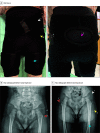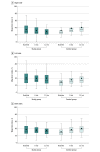Efficacy of a Hip Brace for Hip Displacement in Children With Cerebral Palsy: A Randomized Clinical Trial
- PMID: 36331502
- PMCID: PMC9636519
- DOI: 10.1001/jamanetworkopen.2022.40383
Efficacy of a Hip Brace for Hip Displacement in Children With Cerebral Palsy: A Randomized Clinical Trial
Erratum in
-
Errors in Figures.JAMA Netw Open. 2022 Dec 1;5(12):e2247506. doi: 10.1001/jamanetworkopen.2022.47506. JAMA Netw Open. 2022. PMID: 36454574 Free PMC article. No abstract available.
Abstract
Importance: There is no consensus on interventions to slow the progress of hip displacement in patients with cerebral palsy.
Objective: To investigate the efficacy of a novel hip brace in preventing progressive hip displacement in patients with cerebral palsy.
Design, setting, and participants: This 2-group randomized clinical trial was conducted at 4 tertiary hospitals in South Korea from July 2019 to November 2021. Participants included children aged 1 to 10 years with nonambulatory cerebral palsy (Gross Motor Function Classification System level IV or V). Block randomization was used to assign an equal number of patients to the study and control groups via computerized random allocation sequences. Data were analyzed from November to December 2021.
Interventions: The intervention group wore the hip brace for at least 12 hours a day for the study duration (ie, 12 months). Follow-up evaluations were performed after 6 and 12 months of wearing the brace. Both groups proceeded with conventional rehabilitation therapy during the trial.
Main outcomes and measures: The primary outcome was the Reimers migration index (MI) on radiography, as assessed by 3 blinded investigators. Primary outcome variables were analyzed using linear mixed models. Secondary outcomes include change in the Caregiver Priorities & Child Health Index of Life with Disabilities, on which lower scores indicate better quality of life.
Results: A total of 66 patients were included, with 33 patients (mean [SD] age, 68.7 [31.6] months; 25 [75.8%] boys) randomized to the intervention group and 33 patients (mean [SD] age, 60.7 [24.9] months; 20 [60.6%] boys) randomized to the control group. The baseline mean (SD) MI was 37.4% (19.3%) in the intervention group and 30.6% (16.3%) in the control group. The mean difference of the MI between the intervention group and control group was -8.7 (95% CI, -10.2 to -7.1) percentage points at 6 months and -12.7 (95% CI, -14.7 to -10.7) percentage points at 12 months. The changes in the Caregiver Priorities & Child Health Index of Life with Disabilities were favorable in the study group and reached statistical significance at the 6-month follow-up compared with the control group (difference, -14.2; 95% CI, -25.2 to -3.3).
Conclusions and relevance: In this randomized clinical trial, the novel hip brace was significantly effective in preventing the progression of hip displacement, compared with the control group. It effectively improved quality of life in patients with nonambulatory cerebral palsy. Therefore, hip brace use could be a promising treatment method to delay hip surgery and improve the quality of life of patients with nonambulatory cerebral palsy.
Trial registration: ClinicalTrials.gov Identifier: NCT04033289.
Conflict of interest statement
Figures



Similar articles
-
Effects of hip brace on coxa valga in nonambulatory children with cerebral palsy: A randomized controlled trial.Medicine (Baltimore). 2023 Oct 27;102(43):e35696. doi: 10.1097/MD.0000000000035696. Medicine (Baltimore). 2023. PMID: 37904376 Free PMC article. Clinical Trial.
-
Does botulinum toxin a combined with bracing prevent hip displacement in children with cerebral palsy and "hips at risk"? A randomized, controlled trial.J Bone Joint Surg Am. 2008 Jan;90(1):23-33. doi: 10.2106/JBJS.F.01416. J Bone Joint Surg Am. 2008. PMID: 18171954 Clinical Trial.
-
The impact of complementary and alternative medicine on hip development in children with cerebral palsy.Dev Med Child Neurol. 2013 May;55(5):472-9. doi: 10.1111/dmcn.12094. Epub 2013 Feb 22. Dev Med Child Neurol. 2013. PMID: 23432349
-
Hip Surveillance in Children with Cerebral Palsy.Orthop Clin North Am. 2018 Apr;49(2):181-190. doi: 10.1016/j.ocl.2017.11.006. Epub 2018 Feb 3. Orthop Clin North Am. 2018. PMID: 29499819 Review.
-
Natural History of Spastic Hip Disease.J Pediatr Orthop. 2019 Jul;39(Issue 6, Supplement 1 Suppl 1):S33-S37. doi: 10.1097/BPO.0000000000001347. J Pediatr Orthop. 2019. PMID: 31169645 Review.
Cited by
-
Errors in Figures.JAMA Netw Open. 2022 Dec 1;5(12):e2247506. doi: 10.1001/jamanetworkopen.2022.47506. JAMA Netw Open. 2022. PMID: 36454574 Free PMC article. No abstract available.
-
Hip Surveillance and Management of Hip Displacement in Children with Cerebral Palsy: Clinical and Ethical Dilemmas.J Clin Med. 2023 Feb 19;12(4):1651. doi: 10.3390/jcm12041651. J Clin Med. 2023. PMID: 36836186 Free PMC article.
-
Hip displacement in children with cerebral palsy: surveillance to surgery - a current concepts review.SICOT J. 2024;10:30. doi: 10.1051/sicotj/2024023. Epub 2024 Aug 22. SICOT J. 2024. PMID: 39177434 Free PMC article.
-
Study Confirms Safety and Effectiveness of Intra-Articular Glucocorticoids for Painful Hip Dislocation in Children and Young Adults with Neurologic Impairment.Children (Basel). 2023 Aug 6;10(8):1353. doi: 10.3390/children10081353. Children (Basel). 2023. PMID: 37628352 Free PMC article.
-
Hip reconstruction in cerebral palsy: Lessons from a single center and 137 hips.J Child Orthop. 2023 Sep 5;17(5):469-480. doi: 10.1177/18632521231196846. eCollection 2023 Oct. J Child Orthop. 2023. PMID: 37799318 Free PMC article.
References
-
- Rosenbaum P, Paneth N, Leviton A, et al. . A report: the definition and classification of cerebral palsy April 2006. Dev Med Child Neurol Suppl. 2007;109:8-14. - PubMed

